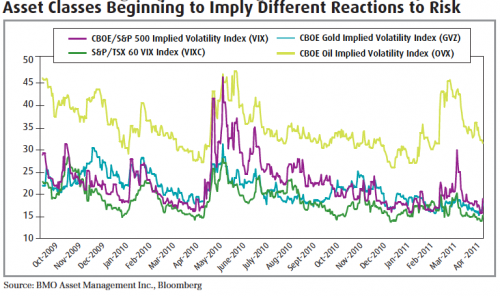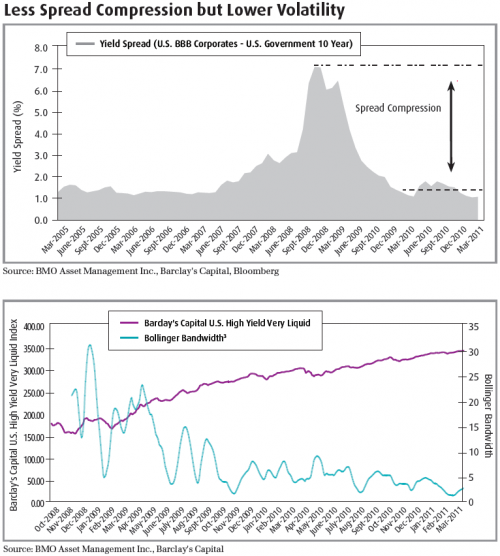Just as commodity sub-sectors are becoming less correlated, we are also seeing correlations between asset classes and sectors slowly decline in a manner similar to an economic thawing process. Additionally, this lower correlation should lead to an eventual end to the “risk-on, risk-off” trade which will further lead to the relative strength of certain sectors over others. Similarly, just as individual commodity sub-groups react to risk factors in the market differently, we are also starting to see the same behaviour with different assets as shown in the implied volatility comparisons below. Therefore at this point of the recovery, we believe a well constructed portfolio should be composed of a static strategic asset allocation mix and a dynamically managed portion that evolves with the market.
For the core portion of the portfolio, investors may want to consider the static asset allocation model portfolios found on our website as a guideline. For the tactically managed portion, we highlight below some ideas that investors may want to consider.
1) U.S. High Yield Corporate Debt. Investors looking for the same performance from U.S. high-yield debt coming out of the 2009 financial crisis will be sorely disappointed. Much of the spread compression between U.S. high yield corporate bonds and U.S. Treasuries is already gone given improved liquidity in the financial system and better access to credit compared to the months that followed the collapse of Lehman Brothers Holding Inc. The U.S. high-yield debt trade should instead be viewed as predominantly of yield at this juncture.
As the chance of company default is far less probable at this point of the economic cycle compared to the depths of the recession in late 2008 and 2009, investors can still get a very respectable yield of 7.9% (as per the Barclay’s Capital U.S. High Yield Very Liquid Index) for taking on far less risk. The recent lowered volatility of U.S. high yield bonds as illustrated below through tighter Bollinger bandwidths may make this space more attractive for some investors.
Bear in mind, however, that U.S. high yield debt reacts to macro-risk factors similarly to equities, so investors should keep their risk allocations in check when reallocating to this area from traditional fixed income.
Potential Investment Opportunity:
- BMO U.S. High Yield Bonds Index ETF (ZHY)
2) REITs. Canadian Real Estate Investment Trusts (REITs) have been one of our favourite areas in the last few years. Originally recommending access to the sector through ETFs such as our BMO Equal Weight REIT Index ETF (ZRE) on July 15, 2010, the index in which it tracks (Dow Jones Canada Select REIT Total Return Index) has returned 26.1% while yielding a healthy 5.4%. When the Canadian REIT sector unexpectedly dropped last November, we issued another report shortly after suggesting it was a buying opportunity and it has since rebounded nicely, recently making new highs.













